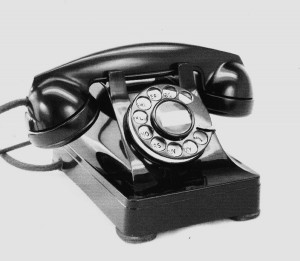For many years, village residents shared their phone lines with neighbors. But, that finally ended in the 1950’s.

Western Electric Phone (1940-50)
Many people consider the introduction of cellular phones as the greatest development in personal communication. However, a lot of “old-timers” would say it was the elimination of party lines and the ability to dial numbers beyond one’s own town. As background, party lines involved one or more homes “sharing” the same telephone line, much the way an extension phone works in your home.
Such arrangements were very common in rural and suburban areas where homes were being built faster than the phone company could expand its services. The problem was, of course, if you picked up your phone and a neighbor was talking, you’d overhear their conversation. The shared line meant that you could not make a call if someone else was using the line, and also that nobody else could call you. They would just get a busy signal.
While businesses and professional people usually had a single line phone service, most residences were on a 2-way party line. With this arrangement, your phone would only ring for your calls. If it was a 3-party or 4-party line, each home would have a distinct ring such as two short rings or one long ring. While this may sound incredible, in 1950, an estimated 75% of all nationwide phone customers were using some type of party line.
In Western Springs, party lines were a way of life for many residents well into the 1950s. That’s because the town was growing so fast that Illinois Bell couldn’t get sufficient supplies of cable and other equipment, let alone install it. Remember, this was the post-war era when everything was still in short supply. Plus, many people actually preferred having a party-line because it was cheaper than having a dedicated line.
Residents also had to dial the operator every time they wanted to call beyond Western Springs. The charge for calls to Chicago and other suburbs ranged between 10¢ and 25¢. But, in 1952, work began on a new 3-story telephone exchange building located at Ashland and Calendar avenues in La Grange. The $750,000 complex ($6.5 million today) was completed in 1954. Now, for the first time, customers in Western Springs, La Grange, La Grange Park, and Brookfield could dial numbers in their entire service area, not just their local town. That’s when Western Springs’ phone numbers were given the CHestnut prefix, which later became “CHestnut 6” and today’s “246.”
Direct long-distance dialing wouldn’t come to Western Springs until the early 1960s. But, according to most “old-timers” it was still great just to be able to call a friend in Downers Grove without having to go through a telephone operator.
